The summer sun is deceptive - it warms softly, but burns strongly.
Contraindications for tanning
Before you decide to sunbathe, make sure that exposure to bright rays will not harm your health.
Contraindications for tanning:
- People of the Celtic phototype – blondes and red-haired people with fair skin. The skin of such people produces little melanin (the pigment responsible for tanning). The main task of melanin is to protect the deep layers of the skin from the harmful effects of ultraviolet radiation. A small amount of it provokes the development of melanoma (skin cancer).
- Children under 5 years of age and adults over 60 years of age, pregnant and lactating women. Don't completely exclude the sun. It is enough to limit your exposure to direct sunlight to reduce the risks of heat and sunstroke. Pregnant women should not sunbathe in the early and late stages, as an increase in body temperature can cause miscarriage or premature birth.
- People with individual contraindications for medical reasons. These include malignant and benign tumors, female diseases (fibroids, erosions), acute tuberculosis, hypertension, skin diseases (psoriasis, dermatitis), thyroid disorders, diabetes mellitus, infectious diseases (mononucleosis, chicken pox, hepatitis), psychoneurological diseases, fever.
By ignoring the above diagnoses, you risk worsening your health condition.
When tuberculosis is in the active phase, the risk of spreading the infection increases.
After suffering from mononucleosis, it is better to abstain from ultraviolet rays for 8 months.
After chickenpox, age spots appear.
Hepatitis damages liver cells.
With diseases of the thyroid gland, the immune system suffers and autoimmune processes are activated (the body stops fighting infection and begins to destroy itself).
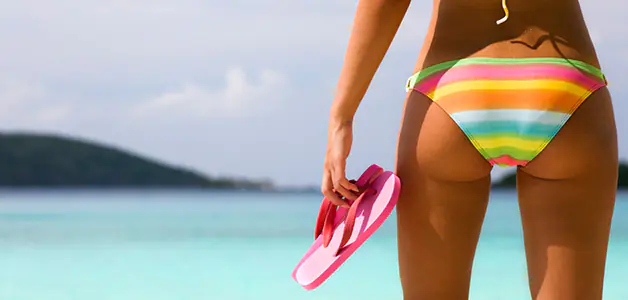
Experts advise avoiding tanning immediately after cosmetic procedures that damage the skin:
- Epilation damages hair roots and deep layers of skin. Ultraviolet rays can increase damage. After hair removal, you should not sunbathe for 3-4 weeks.
- Anti-aging injections. After Botox injections, you should avoid tanning for 2 weeks. Dilated vessels under the influence of rays lead to an unexpected result.
- Hardware cleaning and peeling. When carrying out cleansing procedures, a significant layer of skin is removed; after peeling or cleansing, there is a high risk of sunburn.
- Permanent makeup. The coloring pigment is introduced into the deep layers of the skin. Tanning after a tattoo can lead to a decrease in the quality of the procedure - the colors will fade and the skin will become inflamed.
- Removal of moles and warts. After the procedure, protect the removal site from direct rays for 4 weeks to avoid the appearance of cosmetic defects.
- Wraps with essential oils. Essential oils temporarily clog the pores in the skin, causing inflammation and irritation when exposed to sunlight.
Those taking medications that cause ultraviolet sensitivity and photodermatosis (skin irritation caused by the sun's rays) should also avoid sunbathing in direct sunlight. Sunburn while taking antibiotics, sulfonamides, diuretics, hypoglycemic drugs, antidepressants can worsen your health. When taking the above medications, read the instructions carefully.
Having decided that contraindications are not for you, move on to specific steps to get a beautiful tan.
What to take to the beach
- Suitable suntan products.
- Sunglasses. Bright rays irritate the retina and can even cause burns; the best protection is high-quality sunglasses.
- Headdress. It's difficult to feel your head getting hot, which is why heatstroke is a common occurrence on the beach. You can't do without a sun hat.
- Water. Take clean water with you. When sunbathing, a person loses a large amount of moisture. Drink without waiting for thirst.
- Rug or blanket. You don't want to look like the Sandman. Lying on the sand for a long time is guaranteed to cause skin irritation.
- Sunscreen lip balm. When the sun dries out, your lips become cracked.
- Towel.
Rules for a beautiful tan
The skin will acquire a uniform shade if you follow certain tanning rules.
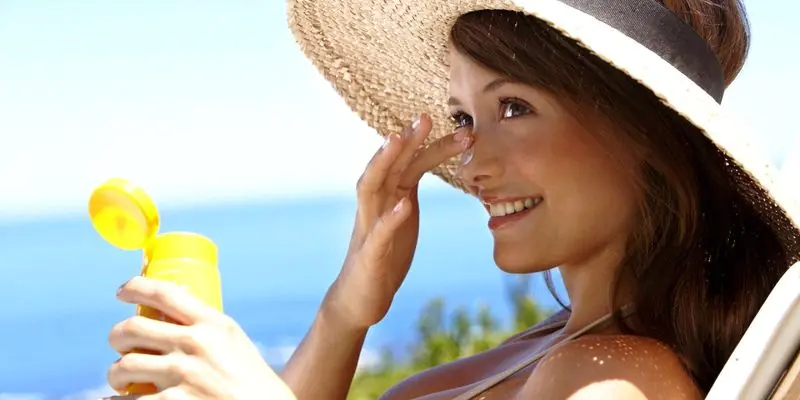
Very soon the long-awaited vacation time will begin: some will go to the sea, while others will be content with outdoor pools or local reservoirs. Nevertheless, everyone wants to get a beautiful tan and avoid burns, which can completely ruin their vacation. In this article we will talk about how to properly sunbathe in the sea and sun. We will separately tell you how to sunbathe correctly with fair skin and how to select products.
How to tan properly in the sun
You can get a tan anywhere: on the beach, minding your own business in your garden, in the solarium. The most luxurious tan is obtained by a pond. The thing is that water reflects the sun's rays and makes the tanning process faster. To get the perfect tan and not burn, follow a few simple rules:
Don't forget about safe hours
All fashion magazines, websites and blogs never cease to remind you about safe hours of sun exposure. We also consider it our duty to remind you of them. The most optimal time for tanning is from 7 am to 11 pm and from 3 pm to 6 pm. The time from 11 to 15 is best spent somewhere indoors. If you are on vacation, then devote this time to spa treatments, have lunch and relax in a cool room, go to the movies, and go to attractions.
Don't forget your hat
Remember that your nose and shoulders burn first, so be sure to take a stylish wide-brimmed hat or cap with you to the beach. This will protect you not only from sunburn, but also from heat stroke, and protect your hair from burning out.
Suntan cream
It is very important to choose the right tanning cream. Those with fair skin should choose a tanning product with an SPF of 40-50, while darker skinned people should choose a tanning product with an SPF of 10-30. But the content of UV filters will protect the epidermis from burns and help achieve an even and beautiful bronze tan. If you are afraid of dryness, premature wrinkles and want to reduce the risk of cancerous skin diseases that can be caused by the sun, then choose a product with another indicator - PPD. Most often, sunscreens with SPF are sold in supermarkets and cosmetic stores, but it is still quite possible to find creams with PPD; in extreme cases, you can always order them in an online store.
Sunbathe in the shade
If you think that by hiding under an umbrella, you were reliably protected from the scorching sun, then you 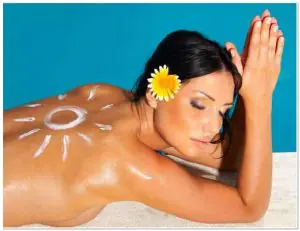
you're wrong. You can get sunburn and burn even in windy and cloudy weather. So, while sitting under your umbrella, don’t forget to look at your watch so you can leave the beach on time.
It is also recommended to turn over as often as possible, Every 4-8 minutes, alternately expose your back and then your stomach to the sun. In order not to forget about these manipulations, it is best not to take an interesting book or magazine with you to the beach. While reading, you can easily get distracted and forget about time.
Try not to fall asleep on the beach, this situation will definitely end in sunburn. For the same reason, you should not go to the beach immediately after eating, as it can make you feel tired. You should not drink alcohol, as it dulls the sensitivity of the skin. And alcohol itself in the heat has a detrimental effect on the cardiac system. Many men argue that beer quenches thirst very well - this is a misconception; only plain water without gas can truly quench thirst.
How to tan properly with fair skin
It's no secret that light aristocratic skin burns very quickly in the sun, therefore it is very important to take action. Some ladies take a course in a solarium several weeks before a trip to the sea, wanting to make their pale skin darker. In addition to solariums, skin tone can be darkened using special bronzers and self-tanners. This procedure can be performed at home, and this dye is washed off in just a week.
Always wear a wide-brimmed hat on the beach and apply a high SPF sunscreen. Usually the effect of the product lasts 3-4 hours, but after swimming it is better to reapply the product. You should also reapply the product every hour if you sweat a lot. Don’t forget that you can burn even while in water, since the sun’s rays penetrate into the water to a depth of two meters. So, even when going for a swim, apply the product.
Turn over frequently while sunbathing. Don't forget to look at your watch. People who rarely tan and only blush in the sun are advised to stay in the sun for no longer than 30 minutes. Those with fair skin and red hair are advised to sunbathe for no more than 45 minutes, and finally, people with fair skin but dark hair can spend about an hour in the sun without harm.
Sunscreens: the right selection
We have already talked a little about tanning products above. Today, many manufacturers offer sprays 
emulsions and suntan creams. Consistency doesn’t matter; it depends more on who is more comfortable applying which one. It is very important to choose a product according to your skin type. Surely you have noticed that the label of such a product contains an SPF indicator. The index of this indicator can vary from 3 to 50. The lighter the skin, the higher the SPF index should be on your tanning product. This protection factor not only protects the skin from ultraviolet rays, but also additionally moisturizes the skin, prevents moisture from evaporating, and also slows down the aging process.
- The cream should be thoroughly rubbed into the skin in a thin layer.
- Read the directions for use on the label carefully. It will indicate at what time interval the tool needs to be updated.
- It is worth noting that many people generously apply the cream to their skin, believing that in this way they will better protect themselves from the harmful rays of the sun, but this is not so.
- On the contrary, in this case the opposite effect will occur, a layer of cream that is too thick will quickly heat up in the sun, which can cause a burn.
If you want not only to protect yourself from ultraviolet radiation, but also to get a chocolate tan, then you can choose a special tanning product. The special components of this cream enhance the production of melanin, which results in a quick and beautiful tan.
Tanning oil
If you are planning to visit the best vacation spots, but you have sensitive skin and it is quite difficult for you 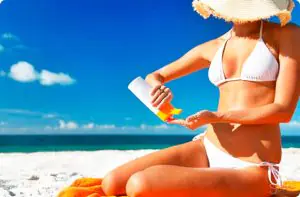
If you choose an industrial tanning cream, you can use natural oil, which enhances the tanning effect and moisturizes the skin. The easiest way is to buy a ready-made mixture of oils, which most often include cocoa, avocado, wheat and palm oils, as well as beta-carotene, antioxidants and SPF factors.
The oil is best applied to clean skin 30-40 minutes before leaving the room. After swimming in a pond, the oil should be reapplied, as it is easily washed off in water. It is worth warning you that if the oil is natural, without SPF factors, then you need to reduce the time you spend in the sun by half, since you will get a tan, but from prolonged exposure to the sun you can get very burnt. We are talking about natural, not industrial oil, to which all the necessary protective components have already been added except oils.
Care and diet for a beautiful tan
After the beach, going to the room and taking a shower, Be sure to apply a soothing cream or special after-sun product. This will soothe the skin and relieve any slight redness that will still occur after sun exposure.
To make your tan last longer, do not use harsh scrubs, washcloths or peels. Additionally, moisturize your skin with special creams or natural masks.
Excellent helps to maintain a beautiful bronze tan products, containing beta-carotene. It is found in foods: carrots, apricots, red bell peppers, watermelons, melons, pears and apples. You can eat it fresh or drink freshly squeezed juices, you can also try a fast diet or a colored diet.
Vitamins E, C, selenium and lycopene promote the production of melanin. Therefore, if you want to get a tan quickly, then take a special complex of minerals a few weeks before your trip to the sea.
Who is contraindicated from sunbathing?
People with very fair or sensitive skin that does not tan, but only turns red in the sun. Tanning is also contraindicated for people with a large number of moles, papillomas and age spots on the surface of the skin. It is also worth refraining from sunbathing if there are very large formations and moles on the skin. Sun rays can trigger random cell division and lead to cancer and other dangerous skin diseases.
People with acute heart disease, high blood pressure, varicose veins, or thrombosis should not sunbathe in the sun.

Two years ago I moved to a city by the sea. I was amazed by the even and rich tan of the locals, and I decided at all costs to learn how to tan like that too. At first, due to lack of knowledge of the technique, after tanning my skin turned red and peeled. I read a lot, practiced and learned how to tan correctly. I’ll talk about this in the article.
Why sunbathe?
First, let's figure out what a tan is and why we need it. Ultraviolet rays damage skin cells. To protect yourself from them, special cells - melanocytes - are activated in the skin. They produce the pigment melanin and use it to create a dark filter on the skin, which absorbs ultraviolet radiation and prevents it from entering the deeper layers of the skin. We call this filter tanning.
The top layer of skin, the epidermis, can be damaged by prolonged exposure to the sun. In this case, the outer stratum corneum of dead skin flakes is replaced with new, living cells.
Vitamin D
One of the benefits of tanning is that it is a natural way to get vitamin D.
Vitamin D Is a fat-soluble vitamin that helps the body absorb calcium and phosphorus in the intestines. And these are strong teeth, nails, hair and bones. Vitamin D also activates the production of the happiness hormone - serotonin - so goodbye depression!
The benefits and harms of tanning
So is tanning harmful or beneficial? It's not the tan itself that's dangerous, but the process of getting it. First, the skin becomes inflamed from sunlight - it turns pink or red. If you immediately sunbathe for a long time, you can get a burn or even develop a blister.
A moderate tan is beneficial, but a burn is harmful. In the table we will look at how a tan and how a burn affects the body.
Comparison of the effects of tanning and burns on the body
A tan
Production of the hormone of happiness
Absorption of calcium and phosphorus
Tone and even skin color
Natural UV protection
Burn
Acceleration of the aging process
Risk of developing melanoma
Dry skin
Growth of age spots
You can't sunbathe:
- with numerous moles on the body, especially large ones;
- for skin diseases - psoriasis, hyperpigmentation, etc.;
- for oncological diseases;
- if relatives had melanomas;
- after chemotherapy;
- after taking antibiotics.
Preparing for tanning
To get an even and successful tan, you need to prepare in advance - determine your photo type, choose clothes and accessories, and prepare your body.
Phototype
There are four main phototypes. Try to clearly determine your photo type using the example of actresses from the TV series “Desperate Housewives”.




Body preparation
Smooth skin - even tan. Before getting your first dose of sunbathing, take your favorite belongings or just an exfoliating glove and remove rough skin cells. I choose a simple and natural option - regular ground coffee.
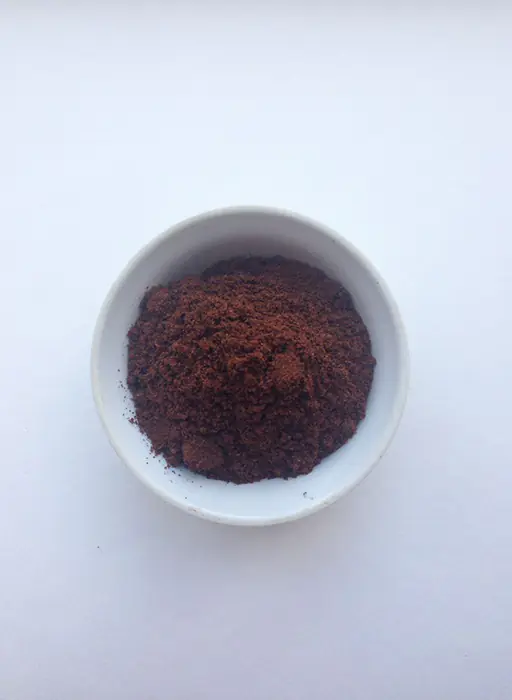
Drink enough fluids. Keep a glass or bottle of water nearby to quench your thirst in a timely manner. There is no need to drink when you don’t want to - it will do more harm than good.
There is no exact figure for how much water you need to drink per day. Regardless of the season. There is an approximate guideline - 30 ml of water per kilogram of body weight. At elevated temperatures outside, this level can increase to 33-35 ml per kilogram, but you shouldn’t get too hung up on that. If a person eats a lot of fruits and greens, he will need less water. How do you know if you're drinking enough? It's simple: lack of thirst and light or colorless urine.

Sunscreens
Sunscreens - creams, sprays, oils - will help to avoid burns. They are divided by level of protection, skin type and place of application - for face, body, hair and so on. It is advisable to apply the product half an hour before going out into the sun - this way it will have time to be absorbed into the deep layers of the skin. Typically, they are applied every two to three hours and after each immersion in water. Exact instructions are indicated on the product label, be sure to read it - conditions for applying sunscreen may vary.
The most vulnerable places are the nose, shoulders and chest. It is better to lubricate them once every half hour.
SPF (sun protection factor) - the main criterion when choosing a sunscreen. It helps to understand how many ultraviolet rays the product blocks, and accordingly, how much the risk of burns will be reduced. At the same time, it is impossible to calculate how long you can safely stay in the sun: the SPF indicator does not characterize time, but an increase in the skin’s resistance to burns. So, a cream with SPF 20 means that your skin is additionally protected by 20%.
Recommended SPF values by phototype
| 1 - Celtic | SPF from 50, high or complete skin protection, tanning does not appear |
| 2 - light-skinned European | SPF from 20 to 50, medium skin protection, light tan |
| 3 - dark-skinned European | SPF from 10 to 20, skin support and hydration, intense tan |
| 4 - Mediterranean | SPF up to 10, intense tan and no formal protective agent needed - only to prevent skin aging |
In addition to the SPF level, when choosing a product, you should take into account the individual characteristics of the skin - sensitivity, oily or dry, tendency to allergies, degree of elasticity and other factors.
Ultraviolet rays are divided into three types:
Types A and B and protection from them falls on our shoulders: look for products on the shelves that say UVA and UVB - they will do the job.
Type C the most dangerous - the ozone layer protects from it.



